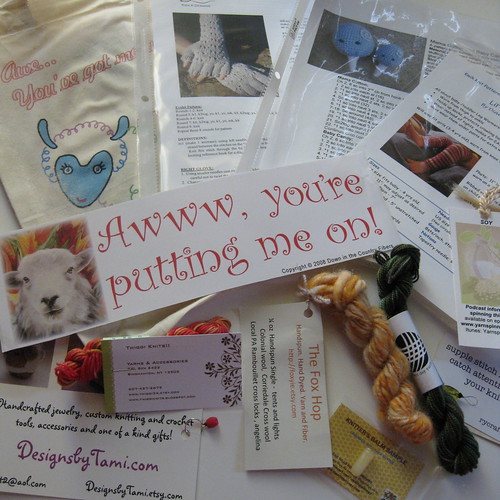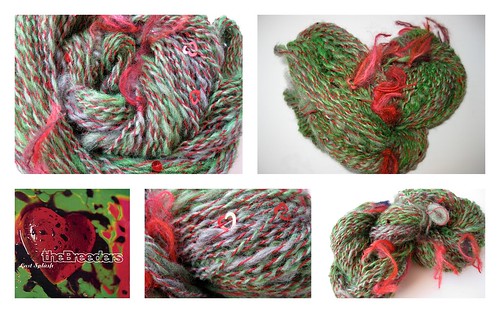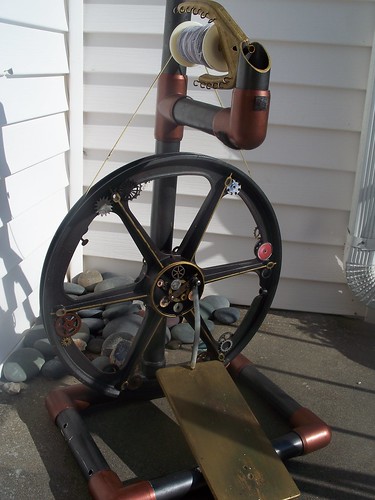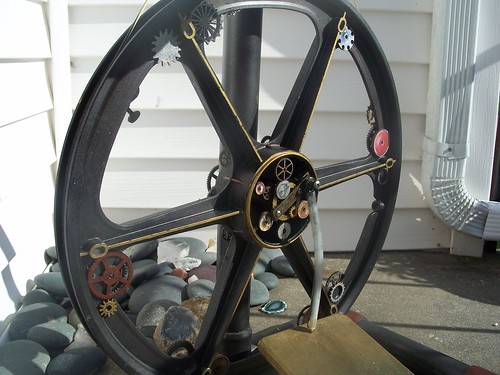Materials:
- ~200 yards of a thick and thin spun, super bulky single (My handspun for the body was Oklahoma-grown Rambouillet fiber from Lowder Colours Farm.)
- 4-8 oz of long, (~6-7") Teeswater wool locks (other varieties of locks could include mohair, Wensleydale, or Suri alpaca to name a few.)
- Size 15 Circular Knitting needles (mine are Denise Interchangeables)
Methods Employed:
- The yarn is a thick and thin single, as I said before. The thickest parts are about the width of my thumb. If you don't know how to spin thick and thin check out Jacey Boggs Sit and Spin! DVD.
2. The Teeswater locks were about 6-7' long and slightly felted on the cut ends. I purchased mine from Lowder Colours Farm right here in Oklahoma. This is important! The slightly felted ends allowed my to create a hole, that you will see to add as fringe. The following images show you how to create the hole.
Once you have all your supplies gathered, we're now onto the "pattern" part.
- Cast on 70 stitches on the size 15 circular knitting needles. Side note here: If you don't like it as large around the neck, decrease the amount of cast on stitches. Keep in mind. though, you will have to increase to get back to the needed number later to get around your shoulders.
- Join beginning and end to form circle. Don't twist the stitches!
- Work four (4) rounds in purl stitch. This will creating a Stockinette that will roll the collar.
- Now, work (2) rounds in knit stitch. This will create a division between this and the next bump.
- Work (4) more rounds in purl stitch.
- Work 10 rounds of knit stitches.
- Increases begin here; make an increase every 7 sts all around. I used Make One Front as seen in the Knitting Help video collection at http://www.knittinghelp.com/videos/increases. This will increase your overall number by 10 sts (80 sts)
- Knit (5) more rounds.
- Increases begin here, make an increase every 8 sts all around. This will increase your overall number by 10 sts (90 sts)
- Knit (2) rows.
- Now for the shaping... and insertion of locks
- We're going to bind off (15) stitches now, but at the same time add locks for the fringe. Using the method above for creating a hole in the tail end of a lock, you will add a lock into the needle before binding off the stitch. As you knit the stitch, you will pull the lock and yarn through as one. It's kind of like thrumming. If you don't know how to do this, check out on the Daily Knitting video at http://www.youtube.com/watch?v=YeCIghU9gT0. Instead of folding the roving, you'll just add the end through and leave the beautiful tip hanging.
- Here's the tricky part because I did not know how much yarn I had so I decided to go until I had enough to bind of. With what I had left, it created a gentle curve, but if you had a lot much yarn, it would eventually come to a point.
- From now on, until you run out of yarn, you will bind off (1) one stitch at the beginning and end of each row while adding a lock or two each time. Your method may be different than mine, but I simply K2Tog (knit two together) on the knit rows, and P2Tog (purl two together) on the purl rows.The more locks you add, the fluffier it'll be, but it will also be harder to knit. Find what's comfortable for you.
- Keep up this pattern until you have just enough yarn to bind off. (I made another 15 rounds before needing to bind off.) Bind off remainder stitches as mentioned in number 12 above.
- Weave in any ends.
If you like this or any other DIY tutorials, feel free to donate directly to me using the link below. I truly appreciate anything you can offer to keep me creating.

















































